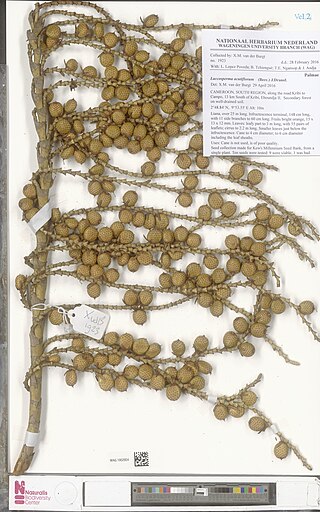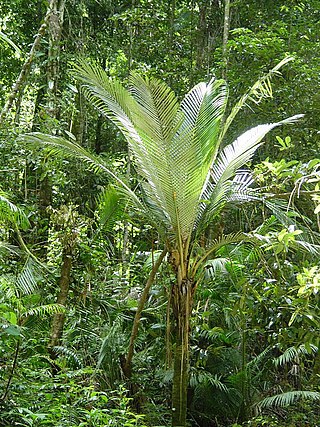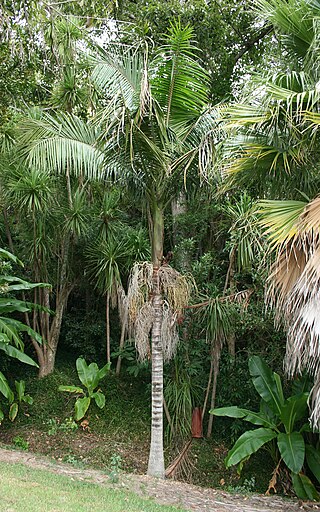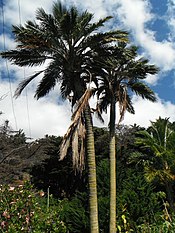
Acanthophoenix is a genus of flowering plants in the palm family from the Mascarene Islands in the Indian Ocean, where they are commonly called palmiste rouge. A genus long in flux, three species are currently recognized, though unsustainable levels of harvesting for their edible palm hearts have brought them all to near extinction in habitat. They are closely related to the Tectiphiala and Deckenia genera, differing in the shape of the staminate flower. The name combines the Greek words for "thorn" and "date palm".

Latania, commonly known as latan palm or latania palm, is a genus of flowering plant in the palm tree family, native to the Mascarene Islands in the western Indian Ocean.

Aphandra is a monotypic genus of flowering plants in the palm family native to the Amazon rainforest vegetation in South America. Its only species is Aphandra natalia, sometimes called mastodon palm or fiber palm, and is used by indigenous peoples in the construction of brooms and other products. This plant is commercially exploited for its edible fruits, and for its leaf sheath and petiole fibers. This fiber is almost equal to the fiber extracted from Attalea funifera and Leopoldinia piassaba, which is called piassava.
Calospatha is an extremely rare, monotypic genus of flowering plant in the palm family found in peninsular Malaysia, where it is referred to as rotan demuk. It is not common in collections, nor has it been found in the wild for several years, leading some to conclude that the species may have become extinct. While not specialized for the task, these dioecious palms are noted for their climbing habit. The genus name is a combination of two Greek words meaning 'beautiful' and 'spathe'.
Clinosperma bractealis is a species of palm tree in the palm family
Cyphokentia macrostachya is a species of palm endemic to New Caledonia.

Laccosperma is a clustering genus of flowering plant in the family palm found in tropical Africa. Poorly studied and rarely cultivated, they are closely related to the genus Eremospatha and with it form a tribe in the Calameae characterized by dyads of hermaphrodite flowers. The genus name combines the Greek words for "reservoir" and "seed".

Leopoldinia is a mostly monoecious genus of flowering plant in the palm family from northern South America, where they are known as jará palm or pissava palm. The two known species are commercially important, especially L. piassaba, which yields sustenance and construction material. The genus is named for Maria Leopoldina, archduchess of Austria, and Brazilian empress.

Lepidorrhachis is a monotypic genus of flowering plant in the palm family restricted to Lord Howe Island. The genus name for the single, monoecious species, Lepidorrhachis mooreana, comes from two Greek word meaning "scale" and "rachis", and the epithet honors Charles Moore, first director of the Sydney Botanical Gardens. The common name is Little Mountain Palm.

Ceratolobus was a dioecious genus of flowering plants in the palm family found in Southeast Asia, commonly called rotan. Its species are now included within the genus Calamus. They are only differentiated from close relatives like Korthalsia, Calamus, and Daemonorops by leaf sheath appendages or inflorescence variations. The Greek genus name combines "horn" and "capsule".
Nenga is a monoecious genus of flowering plant in the palm family. It is native to Southeast Asia and commonly called pinang palm. N. gajah is the aberration in the genus with its short internodes, marcescent leaves and interfoliar inflorescence, a combination of traits seen in a few species of the closely related Pinanga and Areca palms. The genus name is based on a corruption of a Javanese term for a plant now classified within Pinanga.

Oraniopsis is a monotypic genus of flowering plant in the palm family from Queensland, Australia, where the only known species, Oraniopsis appendiculata, grows in mountainous rain forest. Dioecious and extremely slow growing, the name means "similar to Orania" and the Latin epithet translates to "appendaged".
Pogonotium was a dioecious genus of flowering plant in the palm family found in Malaysia and Borneo. Its species are now included within the genus Calamus. Its close relatives are climbing rattans and while partially armed with climbing apparatus, its habit is sprawling and leaning but not effective climbing. The reduced inflorescence nestled between the auricles is unusual and distinguishes it from similar relatives like Calamus, Daemonorops and Ceratolobus. The name is Greek meaning "bearded".
Retispatha is a rare, monotypic genus of flowering plant in the palm family endemic to Borneo, where the sole species, Retispatha dumetosa, is known as wi tebu bruang or 'the bear's sugar cane'. The name combines Latin and Greek words meaning 'network' and 'spathe', and the species epithet means 'bushy'. While classified with other rattans, they retain only superficial climbing organs; they sprawl and lean but are not true climbers.

Archontophoenicinae is a botanical subtribe consisting of four genera of palms, namely Archontophoenix from Queensland and New South Wales and Actinokentia, Chambeyronia and Kentiopsis from New Caledonia. Phylogenetic relationships between the four genera are unresolved.

Rhopalostylidinae is a botanical subtribe consisting of two genera of palms from Australia and New Zealand, Hedyscepe and Rhopalostylis. These two genera were formerly included in Archontophoenicinae, to which they are morphologically similar, until a recent revision.

Calamoideae is a subfamily of flowering plant in the palm family found throughout Central America, South America, Africa, India, China, Southeast Asia and Australia. It is represented by 21 genera - containing nearly a quarter of all species in the palm family - including the largest genus, Calamus, the type genus of the group. Only four are found in the New World while the rest are Old World denizens, usually found in equatorial swampland or along tropical coastlines.

Caryoteae is a tribe in the palm family Arecaceae, distributed across Southeast Asia, from southern India and Sri Lanka east to Vanuatu and northernmost Queensland, Australia. It was long considered a member of subfamily Arecoideae on the basis of its inflorescences, which resemble those of tribe Iriarteeae, and the flowers arranged in triads, which are common across Arecoideae. However, phylogenetic studies based on DNA repeatedly link Caryoteae to subfamily Coryphoideae. Caryoteae do have leaves with induplicate folds, a feature found in most Coryphoid palms, but unlike most Coryphoideae, the leaves are pinnate or bipinnate (Caryota). Phoenix is the only other Coryphoid genus with induplicate, pinnate leaves.

Borasseae is a tribe in the palm subfamily Coryphoideae. The tribe ranges from southern Africa and Madagascar north through the Arabian Peninsula to India, Indochina, Indonesia and New Guinea. Several genera are restricted to islands in the Indian Ocean. The two largest genera, Hyphaene and Borassus, are also the most widespread.

Chuniophoeniceae is a tribe of palms in subfamily Coryphoideae of plant family Arecaceae. The four genera within the tribe are morphologically dissimilar and do not have overlapping distributions. Three of the genera are monotypic, while the fourth genus (Chuniophoenix) has three species.





















